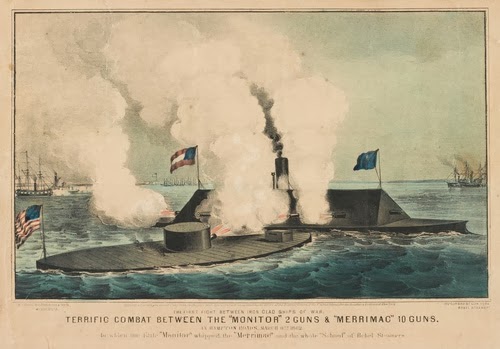On March 9,
1862, during the Civil War, the Monitor and the Virginia (also known as the
Merrimac) clashed to a draw at Hampton Roads, Va., in the first battle between
two ironclad warships.
The Monitor
and the Virginia were the first two ships built by the Union and Confederacy,
respectively, that had iron armor protecting their hulls. The Virginia,
constructed from the wreckage of the Merrimac, left the Norfolk, Va., shipyard
on March 8, 1862, immediately after its completion and sailed to Hampton Roads,
where Union forces were conducting a blockade.
The March 9 New York
Times described the Merrimac as “looking like a submerged house, with
the roof only above water.” The Congress and the Cumberland, two wooden-hulled
Union ships, attacked and “rained full broadsides on the iron-clad monster,
that took, no effect, the balls glancing upwards, and flying off.” The Merrimac
sank the Cumberland using its iron ram (an underwater extension of the bow) and
defeated the Congress in a cannon battle. Then, when the Merrimac was fired on
from ashore, its captain, Franklin Buchanan, ordered that the Congress be
burned.
The
Minnesota ran aground while fleeing the battle, but as darkness fell, Buchanan
decided to return to Norfolk for the night. The Merrimac suffered considerable
damage during the battle; its ram was broken off, its iron plates loosened and
two cannons destroyed. Still, it was in good enough shape to return to the
battle the following day and destroy the Minnesota and other Union ships.
To combat
the Merrimac, Union leadership rushed its own ironclad, the Monitor, to Hampton
Roads from Brooklyn. TheMarch
10 New York Times provided a detailed account of the Monitor’s design
and construction.
The Monitor
arrived on the morning of March 9 and moved to defend the Minnesota. The
Monitor and Merrimac engaged in battle at close range, inflicting considerable
damage on each other. After several hours, the Monitor retreated to waters too
shallow for the Merrimac to navigate to attend to the injuries of its
commanding officer, Lt. John L. Worden, who had been temporarily blinded by a
shell. By the time a new commanding officer had been put in place, the
Merrimac, believing that the Monitor had withdrawn, was already sailing back to
Norfolk.
The battle
therefore ended in a draw, though both sides claimed victory. The Times
correspondent pronounced the Monitor victorious, reporting that it had “routed
the famous rebel iron-clad floating battery.” The Confederates, he wrote, had
frequently averred that the Merrimac “was about to run out, sink the blockading
vessels, and run along the Atlantic coast, and by destroying our men-of-war
effectually raise the blockade. And indeed the first reports yesterday seemed
as if the threat was actually about to be carried out.”
“But she was
no match for the Monitor, who has now effectually Admonished her to keep out of
the Road hereafter.”
The battle
was the last action the Merrimac would ever see. In May 1862, with Union troops
advancing on Norfolk, the Confederacy destroyed the damaged ship rather than
let it fall into Union hands. The Monitor, meanwhile, sank during a storm off
the coast of North Carolina on Dec. 31, 1862.
Though the
battle between Monitor and the Merrimac had little effect on the outcome of the
war, the power and hardiness they displayed at Hampton Roads changed the way
ships were built. The United States Navy and navies in Europe abandoned the
building of wooden ships and began building ironclads, ushering in a new era of
iron warships. (text credit THE LEARNING NETWORK)



_Page_1.jpg)
_Page_2.jpg)













